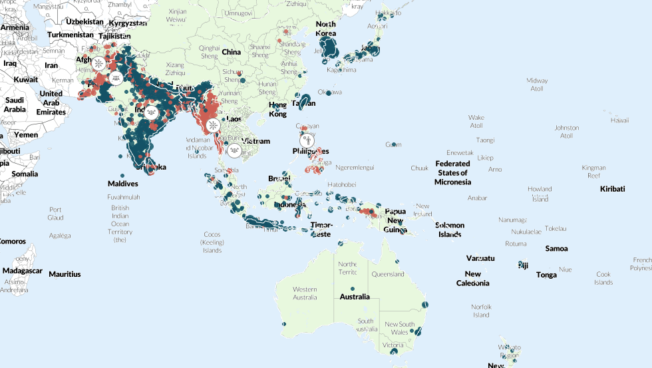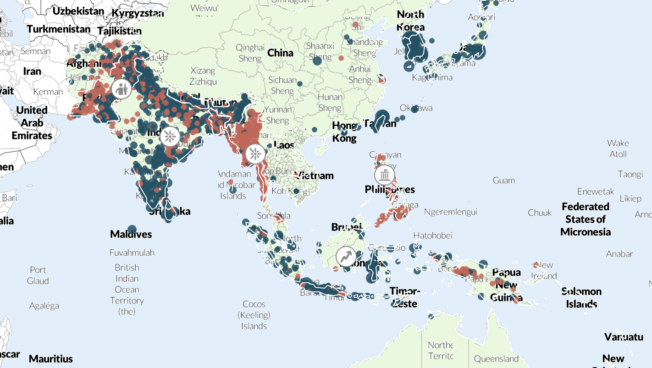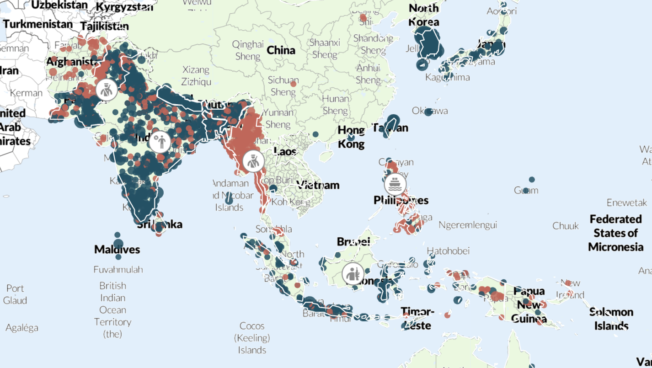Regional Overview
Asia-Pacific
July 2025
Posted: 4 July 2025
In this overview covering June 2025
- Afghanistan: Border tensions between the Taliban and Pakistani forces flare up
- India: Arrest of a Meitei militia leader sparks widespread demonstrations in Manipur
- Myanmar: The KNLA and allies increase their control of the Myanmar-Thailand border
- Pakistan: Tehreek-i-Taliban Pakistan militants increase civilian targeting amid a decline in clashes with security forces
- Philippines: Lethal fighting between the NPA and the military shifts to Eastern Visayas and Caraga
- Thailand: A border dispute with Cambodia leads to protests and the Thai PM’s suspension
Afghanistan: Border tensions between the Taliban and Pakistani forces flare up
Tensions grew between Taliban and Pakistani forces along the Durand Line in June after months of relative stability, as Taliban members and Pakistan border guards exchanged fire in Kunar province. On 14 June, two Taliban members were killed in a confrontation sparked by the new construction of a Pakistani outpost along the disputed Durand Line in Afghanistan’s border Shigal district.1Kabul Now, “Two Taliban Members Killed in Clash with Pakistani Border Guards in Kunar,” 15 June 2025 The construction of border fences along the contested border region, which spans over 2,500 kilometers, often results in clashes as Afghanistan does not recognize the official border that divides Pashtun lands between the two countries.2Amir Latif Arain, “Afghanistan claims it doesn’t have ‘definitive’ border with Pakistan,” Anadolu Ajansi, 28 January 2024
The increase in border clashes comes amid escalating tensions between Afghanistan and Pakistan over the surge in Tehreek-i-Taliban Pakistan (TTP) militancy, which Pakistan accuses the Taliban government of supporting.3Abid Hussain, “As Pakistan, Afghanistan attack each other, what’s next for neighbours?” Al Jazeera, 30 December 2024 Pakistan’s attempts to reduce the infiltration of TTP militants into its territory, by intensifying border fencing and monitoring, have put it in direct confrontation with Taliban forces. Diplomatic measures by Pakistan, such as the closure of border crossings and the drive to deport Afghan refugees, launched in 2023, have further deteriorated trust between the two governments.4International Crisis Group, “Pakistan-Afghanistan: Tempering the Deportation Drive,” 22 May 2025 Citing national security threats, the Pakistani government set a deadline of 30 June for Afghan refugees to leave the country voluntarily, prompting concerns about forced deportations after the deadline.5Ahmad Azizi, “Deadline expires for voluntary return of Afghan refugees from Pakistan,” 3 July 2025
India: Arrest of a Meitei militia leader sparks widespread demonstrations in Manipur
On 7 June, the Central Bureau of Investigation arrested Ashem Kanan Singh, the “army chief” of the Meitei militia Arambai Tenggol, along with four associates, for criminal activities such as cross-border arms smuggling.6Scroll (India), “Manipur relaxes prohibitory orders in valley districts, Arambai Tenggol calls off shutdown,” 11 June 2025 Public demonstrations by Meitei groups against the arrests sparked state government curfews and internet shutdowns, with the Arambai Tenggol also declaring its own “10-day shutdown.”7BBC News, “Curfew and internet shutdown in India’s violence-hit Manipur state,” 9 June 2025 ACLED records more than 40 related demonstration events, nearly half of which turned violent. During a demonstration held in the state capital of Imphal on 7 June, at least 18 people, including two journalists, were injured after security forces fired tear gas shells, live rounds, and other methods to disperse the demonstrators. Following the demonstrations, the four associates were released unconditionally on 8 June, but Singh remained in police custody.8Scroll (India), “Manipur relaxes prohibitory orders in valley districts, Arambai Tenggol calls off shutdown,” 11 June 2025
The Arambai Tenggol came to prominence soon after the outbreak of inter-ethnic violence between members of the majority Meitei and the Kuki-Zo tribal community in Manipur in May 2023. ACLED data show its involvement in more than 50 events of political violence since, including acts of ethnic violence and vigilantism. The recent arrests targeting the Arambai Tenggol indicate a withdrawal of the tacit endorsement the militia received from the previous BJP‑led state government, and the group appears to be losing favor now that Manipur is under the central government’s rule.9Sudha Ramachandran, “Arambai Tenggol: The Meitei Militia Threatening India’s Manipur State,” The Jamestown Foundation, 21 August 2024 However, the proliferation of arms among ethnic militias remains a matter of concern — on 13 June, security forces made the largest single recovery of weapons from the state’s predominantly Meitei-inhabited valley districts since the start of the current conflict.
Myanmar: The KNLA and allies increase their control of the Myanmar-Thailand border
The Karen National Union/Karen National Liberation Army (KNU/KNLA) led several allied groups in major offensives to take control of key locations along the Thailand-Myanmar border in Kayin state and Tanintharyi region in June. On 3 June, the KNU/KNLA alliance captured the Thay Baw Boe border base in Kayin state from the Myanmar military, reportedly killing over 30 junta troops. This leaves two nearby bases — Waw Lay and Oo Kayit Hta — increasingly vulnerable, as both are significant for controlling the Waw Lay area along the border with Thailand. Elsewhere in Kayin state, the KNU/KNLA and allied forces recaptured the Hteekapalae outpost in Kawkayeik township. This is a symbolic outpost that served for a time as the KNU/KNLA headquarters 28 years ago.10Saw Reh, “All but three junta border bases eliminated in Dooplaya, Karen fighters claim”, Myanmar Now, 24 June 2025 The KNU/KNLA and allies were also able to continue preventing the military’s efforts to capture the Asian Highway 1: it continued to block the military’s Aung Zeya column from uniting its groups that are cut off from each other along the road.11Brian Wei, “Myanmar Junta Reinforcements Heading for Myawaddy Reach Dawna Mountains,” The Irrawaddy, 29 April 2024
In the Tanintharyi region, the KNU/KNLA and allies also captured the military’s Baw Di outpost in Dawei township on 10 June, following a three-day siege that forced 40 soldiers to flee into Thailand. The outpost represents a significant strategic gain as it is one of the main sites controlling the Dawei-Htee Khee trade route with Thailand.
The KNU/KNLA’s progress coincided with a significant rise in fatalities, primarily as a result of high-casualty battles with the military. Despite nearly a 50% decrease in battles involving the KNU/KNLA, reported fatalities in June were at their highest since April 2024. As the KNU/KNLA aims to take full control over Myanmar’s border with Thailand, this suggests not only a likely escalation of fighting in the southeastern region in the coming months, but also an increasingly deadly campaign to come.12Facebook, “KNU captures around 50 military camps along Thai-Myanmar border, claimed more significant than taking towns,” Khit Thit Media, 19 May 2025 [Burmese]
Pakistan: Tehreek-i-Taliban Pakistan militants increase civilian targeting amid a decline in clashes with security forces
In June, the Tehreek-i-Taliban Pakistan capitalized on a marked decrease in armed clashes with security forces to entrench its presence in Khyber Pakhtunkhwa province and carry out retributive acts of violence against civilians. Violence targeting civilians by the TTP increased by more than 40% in June compared to the month prior. In mid-June, TTP militants in the Katlang area abducted and killed four people, including the head of a local pro-government militia, whom they suspected of spying for the military.13X @khorasandiary, 20 June 2025 Their mutilated bodies were recovered by police on 20 June. The location of this retributive act of violence is significant; Katlang was the site of a suspected drone strike by the military in March that reportedly claimed the lives of 12 militants and at least nine locals.
Meanwhile, local militias find themselves increasingly drawn into direct conflict with TTP militants. Armed groups made up of local volunteers, known as peace militias, clashed in at least four instances in June, up from just two in May, according to ACLED data. While the influence of these informally organized peace militias waned after the 2015 Zarb-e-Azb military operation that significantly weakened the TTP, they have re-emerged in the wake of the latest surge in TTP militancy.14Salman Yousafzai, “Death by lashkar: The forgotten protectors of Adezai village,” Dawn, 8 May 2016; Sachchal Ahmad, “After Zarb-E-Azb: Now What?,” Stimson Centre, 18 August 2015 Increased activity by irregular armed militias risks further destabilizing an already volatile security situation.
Philippines: Lethal fighting between the NPA and the military shifts to Eastern Visayas and Caraga
Fresh clashes between the communist New People’s Army (NPA) and the military led to multiple rebel deaths in June. On 15 June, three NPA militants were killed in firefights with the military in Placer town, Surigao del Norte, Caraga. Three days later, three more NPA members were killed in Carigara town, Leyte, Eastern Visayas. The next day, three more rebels, as well as a Philippine military soldier, died in another clash in Kalamansig town, Sultan Kudarat, Soccsksargen.
Clashes between the NPA and the military are generally trending lower, decreasing by around 30% in the first half of 2025 compared to the first six months of 2024. However, the fighting has become more concentrated in Eastern Visayas and Caraga — together accounting for 40% of nationwide battles with both recording 10 events in 2025. The NPA and state forces have clashed most frequently in both regions since the start of the year, deviating from long-standing patterns of Western Visayas and Northern Mindanao being the hotspots of the NPA insurgency.
In late June, the military threatened to launch even more aggressive operations against the NPA in Eastern Visayas if the remaining NPA militants in the region did not surrender by 15 July.15Sarwell Meniano, “Army to step up fight vs. NPA in Leyte, Samar after ultimatum,” Philippine News Agency, 23 June 2025 Meanwhile, there has been little progress in the revived peace process between the communist rebels and the government, which was announced in November 2023.16Zacarian Sarao, “Marcos gov’t confident it could sign peace deal with CPP-NPA-NDFP,” INQUIRER.net, 2 September 2024
Thailand: A border dispute with Cambodia leads to protests and the Thai PM’s suspension
Thousands of protesters, primarily aligned with the royalist “Yellow Shirts” movement, gathered in Bangkok on 28 June to demand the resignation of Prime Minister Paetongtarn Shinawatra over her recent handling of a long-standing border dispute with Cambodia.17Thai PBS, ‘Protest leaders call for “PM to resign – coalition parties to withdraw,’’ 28 Jun 2025 On 1 July, the Constitutional Tribunal accepted a petition from senators accusing her of a breach of ethics and suspended her from office.
On 28 May, the Thai and Cambodian militaries exchanged fire near the disputed Preah Vihear temple, leaving a Cambodian soldier dead. This was the first fatal military incident between the two countries since the 2011 skirmishes in the same area.18Bangkok Post, “Cambodian soldier killed in Thai border gunfight,” 28 May 2025 Thai military sources accused Cambodian forces of crossing into Thai territory and constructing defensive trenches — an allegation Phnom Penh denies.19Jintamas Saksornchai, “Protesters rally in Bangkok to demand Thai prime minister’s resignation over leaker Cambodia call,” Associated Press, 28 June 2025
A broader political crisis, though, began in Thailand in mid-June when a phone call between Paetongtarn and former Cambodian Prime Minister Hun Sen was leaked online. In the call, Paetongtarn referred to a Thai army commander as an “opponent” and addressed Hun Sen as “uncle.” These remarks were perceived by parts of society as disrespectful to the military and undermining national sovereignty.20Bangkok Post, “Paetongtarn on defensive after leak of call with Hun Sen,” 18 Jun 2025 The Bhumjaithai Party, the second-largest coalition member, then withdrew from the Pheu Thai party-led coalition government, stripping Paetongtarn of her parliamentary majority.
See More
See the Codebook and the User Guide for an overview of ACLED’s core methodology. For additional documentation, check the Knowledge Base. Region-specific methodology briefs can be accessed below.
Links:
- Methodology and Coding Decisions for Political Violence and Demonstrations in Afghanistan
- Methodology and Coding Decisions for Political Violence and Demonstrations in China and Taiwan
- Methodology and Coding Decisions for Political Violence and Demonstrations in Myanmar
- Methodology and Coding Decisions for Political Violence and Demonstrations in North Korea







